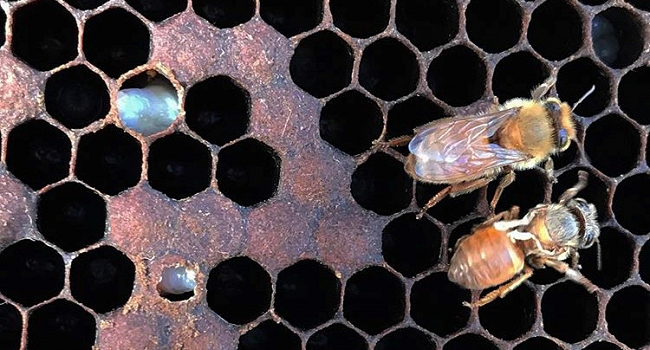Honeybees are at the heart of global agriculture, playing a crucial role in pollination and supporting ecosystems worldwide. However, these hardworking insects face numerous challenges, with one of the most dangerous being the Varroa destructor mite. Beyond the physical damage varroa mites inflict, they act as vectors for a wide range of deadly viruses, amplifying their impact on bee colonies. In this post, we’ll explore the most common viruses spread by varroa mites and how they contribute to colony collapse.
How Varroa Mites Spread Viruses
Varroa mites are parasitic creatures that feed on the hemolymph (the bee’s equivalent of blood) of honeybees. When they latch onto bees, they inject viral pathogens into the bee’s body through their feeding, serving as both a mechanical vector and a biological reservoir for several viruses. Infected bees spread these viruses within the hive, often leading to widespread disease that can devastate entire colonies.
Common Viruses Spread by Varroa Mites
- Deformed Wing Virus (DWV)
Deformed Wing Virus is the most prevalent and dangerous virus spread by varroa mites. Bees infected with DWV often have deformed, crumpled wings, making them unable to fly or forage. This virus impairs the development of bees and leads to early death. In heavily infested colonies, DWV can contribute to colony collapse, especially in winter when bee populations are already vulnerable. - Acute Bee Paralysis Virus (ABPV)
ABPV is another highly contagious virus transmitted by varroa mites. Infected bees exhibit symptoms of paralysis, such as trembling, inability to fly, and bloating. The virus affects both adult bees and brood, leading to premature death. Colonies with high levels of ABPV often experience significant bee loss and are more susceptible to collapse, particularly during times of stress. - Chronic Bee Paralysis Virus (CBPV)
Unlike ABPV, which causes sudden paralysis, Chronic Bee Paralysis Virus results in long-term symptoms. Bees become sluggish, lose their hair (giving them a shiny appearance), and can eventually die. CBPV spreads more slowly than DWV and ABPV but can still weaken colonies over time, especially when combined with other viral infections. - Israeli Acute Paralysis Virus (IAPV)
Israeli Acute Paralysis Virus causes sudden death in bees and can wipe out large portions of a colony in a short time. Like other varroa-spread viruses, IAPV weakens the immune systems of infected bees, making them more vulnerable to secondary infections. IAPV is often implicated in cases of Colony Collapse Disorder (CCD), where worker bees disappear from the hive, leaving behind the queen and immature brood. - Sacbrood Virus (SBV)
Sacbrood Virus primarily affects bee larvae, leading to their death before they fully develop. Infected larvae take on a sac-like appearance as they fail to pupate properly. While SBV is less harmful to adult bees, it can significantly reduce the population of new bees, leading to weakened colonies that are less able to survive environmental stresses or varroa infestations.
Impact of Varroa-Spread Viruses on Colonies
Varroa mites weaken bees physically by draining their hemolymph, but their role as vectors for viruses exacerbates the damage. Colonies infested with varroa often suffer from multiple viral infections simultaneously, which increases stress and reduces the bees’ ability to fight off pathogens. These viral infections lead to:
- Decreased Lifespan: Infected bees die sooner, leaving the colony short of worker bees essential for foraging and tending to the queen and brood.
- Poor Brood Health: Viruses like DWV and SBV directly affect the brood, reducing the number of healthy new bees.
- Reduced Immunity: Bees with multiple viral infections become more susceptible to other diseases, such as Nosema or bacterial infections.
- Colony Collapse: The combination of weakened adult bees, a failing queen, and poor brood health can lead to complete colony collapse.
Managing Varroa and Viral Infections
Controlling varroa mite populations is the most effective way to reduce the spread of these viruses. Beekeepers have a variety of options for managing varroa, including:
- Chemical Treatments: Using approved miticides can significantly reduce varroa mite levels, but beekeepers need to rotate treatments to prevent mites from developing resistance.
- Mechanical Methods: Techniques like drone brood removal and screened bottom boards can help reduce mite numbers without chemicals.
- Breeding for Resistance: Some bees, like VSH (Varroa Sensitive Hygiene) bees, have been selectively bred to detect and remove infected brood, which helps control varroa infestations and viral transmission.
Conclusion
Varroa mites pose a double threat to honeybees by not only weakening them through parasitism but also by acting as carriers of deadly viruses. These viral infections significantly increase the chances of colony collapse, making varroa management a top priority for beekeepers worldwide. By controlling mite levels and being vigilant about viral symptoms, beekeepers can help protect their colonies from the devastating impact of varroa-spread viruses.
Further Reading:
- Bee Informed Partnership – Varroa and Viral Diseases
- International Bee Research Association – Understanding Varroa Mite-Virus Interactions
- National Bee Unit – Managing Varroa and Associated Viruses
